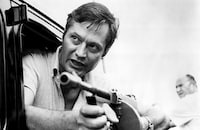Tower of London

Brief Synopsis
Cast & Crew
Roger Corman
Vincent Price
Michael Pate
Joan Freeman
Robert Brown
Justice Watson
Film Details
Technical Specs

Synopsis
As King Edward IV of England lies dying, his hunchbacked brother, Richard of Gloucester, plots to do away with all who stand between him and the throne. To protect his two young sons until they are old enough to replace him, Edward appoints his other brother, Clarence, as Protector of the Realm, but Richard murders Clarence with a knife bearing the queen's crest. Now suspicious of his wife, Edward appoints Richard to Clarence's former position, and Richard, with the aid of his henchman Sir Ratcliffe, tries to get the royal nursemaid Mistress Shore to cast doubt on the boys' legitimacy; she prefers dying on the rack, however, to defaming the queen. Meanwhile, the queen has gathered her supporters and been assured by Margaret, her lady-in-waiting, that Scottish armies led by the latter's father, Lord Stanley, will offer military aid against Richard. When Richard sees the bloodied apparition of Mistress Shore, he becomes deranged and murders his wife, Anne. Maddened with fear and haunted by visions, Richard holds Margaret hostage to prevent her father from moving against him, suffocates the two young princes in the Tower of London, and proclaims himself king. Through a ruse, Margaret is released, forcing Richard into battle against Lord Stanley. The Earl of Richmond's army arrives from France to join in combat against Richard at Bosworth, where the ghosts of Richard's victims rise against him; he is thrown by a horse and lands on the battle-ax of a dead soldier, fulfilling prophecies of his violent death.

Director

Roger Corman
Cast

Vincent Price

Michael Pate
Joan Freeman
Robert Brown
Justice Watson
Sarah Selby
Richard Mccauly
Eugene Martin
Sandra Knight
Richard Hale
Donald Losby
Bruce Gordon

Joan Camden
Sara Taft
Crew
Michael Andersen
Jack Bohrer
Jack Bohrer
Francis Coppola
Gene Corman
Arch R. Dalzell
James B. Gordon
Leo Gordon
Daniel Haller
Phil Mitchell
Amos Powell
Amos Powell
Ronald Sinclair

Videos
Movie Clip


Film Details
Technical Specs

Articles
Tower of London (1962)
In Interviews with B Science Fiction and Horror Movie Makers by Tom Weaver, Gene Corman, the producer of Tower of London and the brother of director Roger Corman, recalled the inspiration for the film: " (Screenwriter) Leo Gordon and I were trying to come up with a variation on that genre - not to do Edgar Allan Poe, because it seemed to me that Vincent Price had done enough of those. We were looking to find another venue; we talked about Nathaniel Hawthorne, and three or four other ideas. Then I said to Leo, 'Why don't we go to Shakespeare, and see where that takes us?' MacBeth didn't serve us, but the story of Richard III did. So that was how that came about - we were exploring the same genre, but a different author."
It all started promisingly enough according to the director in Ed Naha's book The Films of Roger Corman: Brilliance on a Budget: "My brother knew an independent producer named Eddie Small. Eddie liked the Poe films and wanted to bankroll a similar picture....I had a fifteen-day shooting schedule and my old crew, so I thought that everything would run smoothly." Then came the bad news. "To my great surprise," Corman said, "I found out that I was supposed to shoot the picture in black and white. Somehow, nobody had bothered to tell me that! I was flabbergasted. This was 1963. I shot the movie, but I think it suffered from the lack of color."
Though Tower of London is no masterpiece, it's still an enjoyable Grand Guignol, thanks to Vincent Price's flamboyantly villainous performance and the atmospheric cinematography which favors dank corridors and secret passageways lined with cobwebs. Most interesting is the fact that Price also appeared in the 1939 version of Tower of London but as a victim - the ill-fated Duke of Clarence. Another fun trivia tidbit: Price had originally committed to starring in an adaptation of Poe's The Gold Bug but began work instead on Tower of London when the former project died in "development hell." It was also directly after starring in Tower of London that Price began his long and successful partnership with the Sears Roebuck and Company chain, buying inexpensive European art for their American stores.
Producer: Gene Corman
Director: Roger Corman
Screenplay: Leo Gordon, F. Amos Powell, Robert E. Kent
Art Direction: Daniel Haller
Cinematography: Archie R. Dalzell
Costume Design: Marjorie Corso
Dialogue Director: Francis Ford Coppola
Cast: Vincent Price (Richard of Gloucester), Michael Pate (Sir Ratcliffe), Robert Brown (Sir Justin), Charles Macaulay (Clarence), Joan Freeman (Lady Margaret), Bruce Gordon (Earl of Buckingham), Joan Camden (Anne).
BW-80m.
by Jeff Stafford

Tower of London (1962)
Quotes
Trivia
The Battle of Bosworth is made up of stock footage from the original Universal version of Tower of London (1939).
This feature was planned for filming in color. On the Thursday before the Monday start of principle photography, uncredited executive producer Edward Small informed producer Gene Corman that it was going to be shot in black and white.
Notes
Previously filmed in 1939 by Universal Pictures.

Miscellaneous Notes
Released in United States Fall October 24, 1962
Remake of the 1939 film of the same name, directed by Rowland V Lee.
Released in USA on video.
Released in United States Fall October 24, 1962













